(4) (5 points) Intelligent Farm Machineries, Inc. (NYSE: IFM) has a total market value of $100 million, consisting of $50 million of common equity and $50 million of 10% perpetual bonds now selling at par, i.e., YTM =10%. IFM's EBIT is $10 million, and its tax rate is 20%. The company can change its capital structure by either increasing its debt to 60% (based on market value) or decreasing it to 40%. If it decides to increase its use of financial leverage, it must call its old bonds and issue new ones with a 14% coupon. If it decides to decrease its leverage, it will call its old bonds and replace them with new 6% coupon bonds. The firm will sell or repurchase stock at the new equilibrium price to complete the capital structure change. The firm pays out all earnings as dividends; hence its stock is a zero-growth stock. Its current cost of equity, r5, is 16%. If it increases leverage, r5 will be 20%. If it decreases leverage, r5 will be 12%. Answer the following questions based on the assumptions: 1. Assume that the firm can sell new bonds at par regardless of its leverage ratios. 2. No required investment in capital is needed. Hence, FCF= NOPAT =EBIT(1T). 3. Assume that the constant growth valuation formula with the growth rate 0 is appropriate and the value of nonoperating assets is zero. Questions (Show all work): (a) What is the firm's WACC and total corporate value under the current capital structure? (b) What is the firm's WACC and total corporate value under the 60% debt ratio? (c) What is the firm's WACC and total corporate value under the 40% debt ratio? (4) (5 points) Intelligent Farm Machineries, Inc. (NYSE: IFM) has a total market value of $100 million, consisting of $50 million of common equity and $50 million of 10% perpetual bonds now selling at par, i.e., YTM =10%. IFM's EBIT is $10 million, and its tax rate is 20%. The company can change its capital structure by either increasing its debt to 60% (based on market value) or decreasing it to 40%. If it decides to increase its use of financial leverage, it must call its old bonds and issue new ones with a 14% coupon. If it decides to decrease its leverage, it will call its old bonds and replace them with new 6% coupon bonds. The firm will sell or repurchase stock at the new equilibrium price to complete the capital structure change. The firm pays out all earnings as dividends; hence its stock is a zero-growth stock. Its current cost of equity, r5, is 16%. If it increases leverage, r5 will be 20%. If it decreases leverage, r5 will be 12%. Answer the following questions based on the assumptions: 1. Assume that the firm can sell new bonds at par regardless of its leverage ratios. 2. No required investment in capital is needed. Hence, FCF= NOPAT =EBIT(1T). 3. Assume that the constant growth valuation formula with the growth rate 0 is appropriate and the value of nonoperating assets is zero. Questions (Show all work): (a) What is the firm's WACC and total corporate value under the current capital structure? (b) What is the firm's WACC and total corporate value under the 60% debt ratio? (c) What is the firm's WACC and total corporate value under the 40% debt ratio







